Ke Wu
A Hybrid Hinge-Beam Continuum Robot with Passive Safety Capping for Real-Time Fatigue Awareness
Sep 11, 2025Abstract:Cable-driven continuum robots offer high flexibility and lightweight design, making them well-suited for tasks in constrained and unstructured environments. However, prolonged use can induce mechanical fatigue from plastic deformation and material degradation, compromising performance and risking structural failure. In the state of the art, fatigue estimation of continuum robots remains underexplored, limiting long-term operation. To address this, we propose a fatigue-aware continuum robot with three key innovations: (1) a Hybrid Hinge-Beam structure where TwistBeam and BendBeam decouple torsion and bending: passive revolute joints in the BendBeam mitigate stress concentration, while TwistBeam's limited torsional deformation reduces BendBeam stress magnitude, enhancing durability; (2) a Passive Stopper that safely constrains motion via mechanical constraints and employs motor torque sensing to detect corresponding limit torque, ensuring safety and enabling data collection; and (3) a real-time fatigue-awareness method that estimates stiffness from motor torque at the limit pose, enabling online fatigue estimation without additional sensors. Experiments show that the proposed design reduces fatigue accumulation by about 49% compared with a conventional design, while passive mechanical limiting combined with motor-side sensing allows accurate estimation of structural fatigue and damage. These results confirm the effectiveness of the proposed architecture for safe and reliable long-term operation.
Lightweight Kinematic and Static Modeling of Cable-Driven Continuum Robots via Actuation-Space Energy Formulation
Sep 04, 2025Abstract:Continuum robots, inspired by octopus arms and elephant trunks, combine dexterity with intrinsic compliance, making them well suited for unstructured and confined environments. Yet their continuously deformable morphology poses challenges for motion planning and control, calling for accurate but lightweight models. We propose the Lightweight Actuation Space Energy Modeling (LASEM) framework for cable driven continuum robots, which formulates actuation potential energy directly in actuation space. LASEM yields an analytical forward model derived from geometrically nonlinear beam and rod theories via Hamilton's principle, while avoiding explicit modeling of cable backbone contact. It accepts both force and displacement inputs, thereby unifying kinematic and static formulations. Assuming the friction is neglected, the framework generalizes to nonuniform geometries, arbitrary cable routings, distributed loading and axial extensibility, while remaining computationally efficient for real-time use. Numerical simulations validate its accuracy, and a semi-analytical iterative scheme is developed for inverse kinematics. To address discretization in practical robots, LASEM further reformulates the functional minimization as a numerical optimization, which also naturally incorporates cable potential energy without explicit contact modeling.
Drive in Corridors: Enhancing the Safety of End-to-end Autonomous Driving via Corridor Learning and Planning
Apr 10, 2025Abstract:Safety remains one of the most critical challenges in autonomous driving systems. In recent years, the end-to-end driving has shown great promise in advancing vehicle autonomy in a scalable manner. However, existing approaches often face safety risks due to the lack of explicit behavior constraints. To address this issue, we uncover a new paradigm by introducing the corridor as the intermediate representation. Widely adopted in robotics planning, the corridors represents spatio-temporal obstacle-free zones for the vehicle to traverse. To ensure accurate corridor prediction in diverse traffic scenarios, we develop a comprehensive learning pipeline including data annotation, architecture refinement and loss formulation. The predicted corridor is further integrated as the constraint in a trajectory optimization process. By extending the differentiability of the optimization, we enable the optimized trajectory to be seamlessly trained within the end-to-end learning framework, improving both safety and interpretability. Experimental results on the nuScenes dataset demonstrate state-of-the-art performance of our approach, showing a 66.7% reduction in collisions with agents and a 46.5% reduction with curbs, significantly enhancing the safety of end-to-end driving. Additionally, incorporating the corridor contributes to higher success rates in closed-loop evaluations.
VINGS-Mono: Visual-Inertial Gaussian Splatting Monocular SLAM in Large Scenes
Jan 14, 2025



Abstract:VINGS-Mono is a monocular (inertial) Gaussian Splatting (GS) SLAM framework designed for large scenes. The framework comprises four main components: VIO Front End, 2D Gaussian Map, NVS Loop Closure, and Dynamic Eraser. In the VIO Front End, RGB frames are processed through dense bundle adjustment and uncertainty estimation to extract scene geometry and poses. Based on this output, the mapping module incrementally constructs and maintains a 2D Gaussian map. Key components of the 2D Gaussian Map include a Sample-based Rasterizer, Score Manager, and Pose Refinement, which collectively improve mapping speed and localization accuracy. This enables the SLAM system to handle large-scale urban environments with up to 50 million Gaussian ellipsoids. To ensure global consistency in large-scale scenes, we design a Loop Closure module, which innovatively leverages the Novel View Synthesis (NVS) capabilities of Gaussian Splatting for loop closure detection and correction of the Gaussian map. Additionally, we propose a Dynamic Eraser to address the inevitable presence of dynamic objects in real-world outdoor scenes. Extensive evaluations in indoor and outdoor environments demonstrate that our approach achieves localization performance on par with Visual-Inertial Odometry while surpassing recent GS/NeRF SLAM methods. It also significantly outperforms all existing methods in terms of mapping and rendering quality. Furthermore, we developed a mobile app and verified that our framework can generate high-quality Gaussian maps in real time using only a smartphone camera and a low-frequency IMU sensor. To the best of our knowledge, VINGS-Mono is the first monocular Gaussian SLAM method capable of operating in outdoor environments and supporting kilometer-scale large scenes.
HGS-Planner: Hierarchical Planning Framework for Active Scene Reconstruction Using 3D Gaussian Splatting
Sep 26, 2024Abstract:In complex missions such as search and rescue,robots must make intelligent decisions in unknown environments, relying on their ability to perceive and understand their surroundings. High-quality and real-time reconstruction enhances situational awareness and is crucial for intelligent robotics. Traditional methods often struggle with poor scene representation or are too slow for real-time use. Inspired by the efficacy of 3D Gaussian Splatting (3DGS), we propose a hierarchical planning framework for fast and high-fidelity active reconstruction. Our method evaluates completion and quality gain to adaptively guide reconstruction, integrating global and local planning for efficiency. Experiments in simulated and real-world environments show our approach outperforms existing real-time methods.
A Novel Aerial-Aquatic Locomotion Robot with Variable Stiffness Propulsion Module
Sep 15, 2024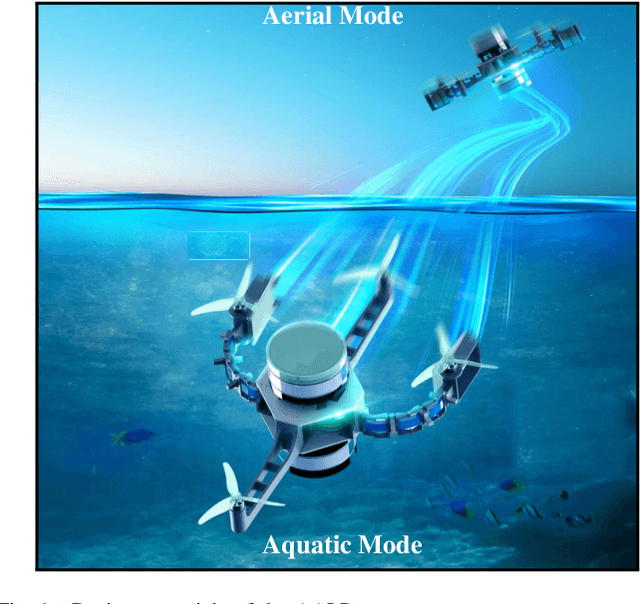
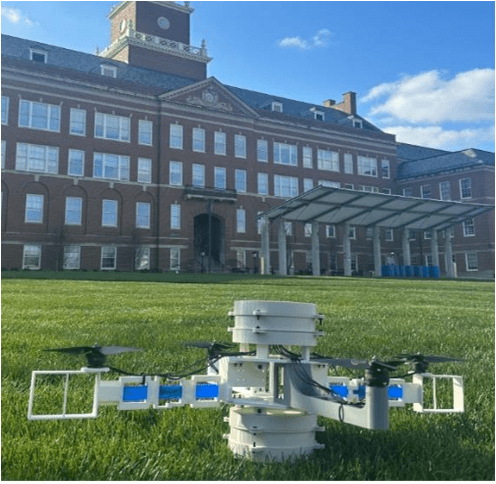
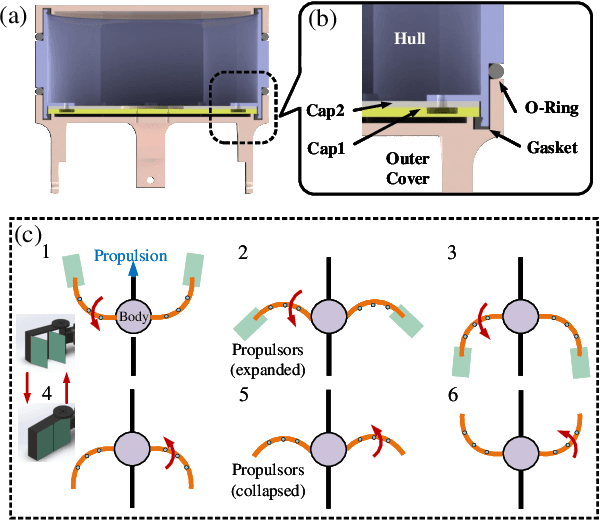
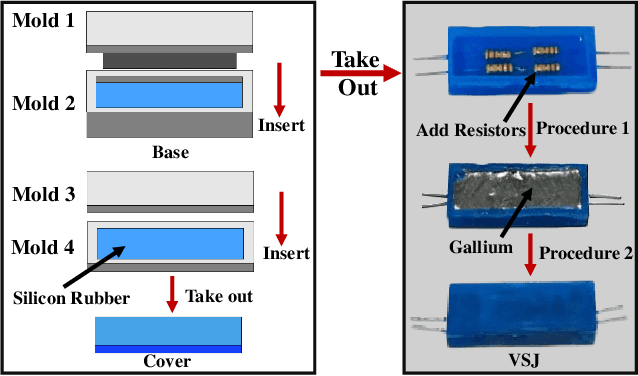
Abstract:In recent years, the development of robots capable of operating in both aerial and aquatic environments has gained significant attention. This study presents the design and fabrication of a novel aerial-aquatic locomotion robot (AALR). Inspired by the diving beetle, the AALR incorporates a biomimetic propulsion mechanism with power and recovery strokes. The variable stiffness propulsion module (VSPM) uses low melting point alloy (LMPA) and variable stiffness joints (VSJ) to achieve efficient aquatic locomotion while reduce harm to marine life. The AALR's innovative design integrates the VSPM into the arms of a traditional quadrotor, allowing for effective aerial-aquatic locomotion. The VSPM adjusts joint stiffness through temperature control, meeting locomotion requirements in both aerial and aquatic modes. A dynamic model for the VSPM was developed, with optimized dimensional parameters to increase propulsion force. Experiments focused on aquatic mode analysis and demonstrated the AALR's swimming capability, achieving a maximum swimming speed of 77 mm/s underwater. The results confirm the AALR's effective performance in water environment, highlighting its potential for versatile, eco-friendly operations.
NumLLM: Numeric-Sensitive Large Language Model for Chinese Finance
May 01, 2024



Abstract:Recently, many works have proposed various financial large language models (FinLLMs) by pre-training from scratch or fine-tuning open-sourced LLMs on financial corpora. However, existing FinLLMs exhibit unsatisfactory performance in understanding financial text when numeric variables are involved in questions. In this paper, we propose a novel LLM, called numeric-sensitive large language model (NumLLM), for Chinese finance. We first construct a financial corpus from financial textbooks which is essential for improving numeric capability of LLMs during fine-tuning. After that, we train two individual low-rank adaptation (LoRA) modules by fine-tuning on our constructed financial corpus. One module is for adapting general-purpose LLMs to financial domain, and the other module is for enhancing the ability of NumLLM to understand financial text with numeric variables. Lastly, we merge the two LoRA modules into the foundation model to obtain NumLLM for inference. Experiments on financial question-answering benchmark show that NumLLM can boost the performance of the foundation model and can achieve the best overall performance compared to all baselines, on both numeric and non-numeric questions.
O2V-Mapping: Online Open-Vocabulary Mapping with Neural Implicit Representation
Apr 10, 2024Abstract:Online construction of open-ended language scenes is crucial for robotic applications, where open-vocabulary interactive scene understanding is required. Recently, neural implicit representation has provided a promising direction for online interactive mapping. However, implementing open-vocabulary scene understanding capability into online neural implicit mapping still faces three challenges: lack of local scene updating ability, blurry spatial hierarchical semantic segmentation and difficulty in maintaining multi-view consistency. To this end, we proposed O2V-mapping, which utilizes voxel-based language and geometric features to create an open-vocabulary field, thus allowing for local updates during online training process. Additionally, we leverage a foundational model for image segmentation to extract language features on object-level entities, achieving clear segmentation boundaries and hierarchical semantic features. For the purpose of preserving consistency in 3D object properties across different viewpoints, we propose a spatial adaptive voxel adjustment mechanism and a multi-view weight selection method. Extensive experiments on open-vocabulary object localization and semantic segmentation demonstrate that O2V-mapping achieves online construction of language scenes while enhancing accuracy, outperforming the previous SOTA method.
HGS-Mapping: Online Dense Mapping Using Hybrid Gaussian Representation in Urban Scenes
Mar 29, 2024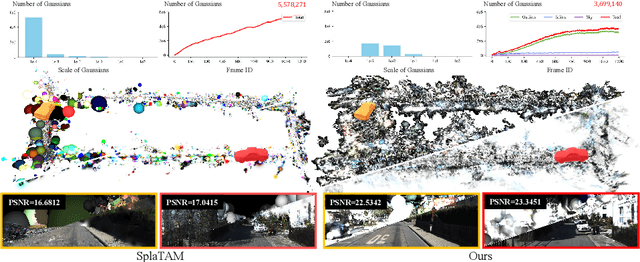

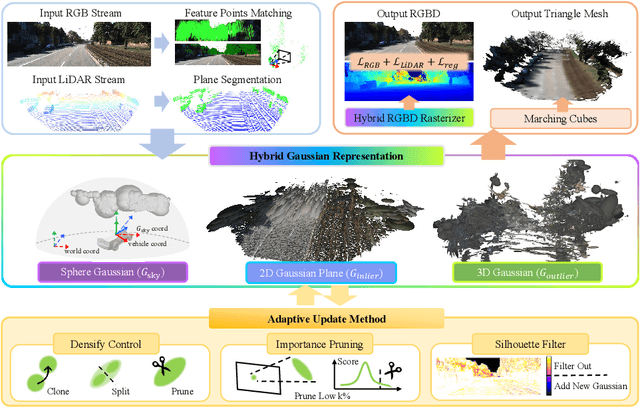

Abstract:Online dense mapping of urban scenes forms a fundamental cornerstone for scene understanding and navigation of autonomous vehicles. Recent advancements in mapping methods are mainly based on NeRF, whose rendering speed is too slow to meet online requirements. 3D Gaussian Splatting (3DGS), with its rendering speed hundreds of times faster than NeRF, holds greater potential in online dense mapping. However, integrating 3DGS into a street-view dense mapping framework still faces two challenges, including incomplete reconstruction due to the absence of geometric information beyond the LiDAR coverage area and extensive computation for reconstruction in large urban scenes. To this end, we propose HGS-Mapping, an online dense mapping framework in unbounded large-scale scenes. To attain complete construction, our framework introduces Hybrid Gaussian Representation, which models different parts of the entire scene using Gaussians with distinct properties. Furthermore, we employ a hybrid Gaussian initialization mechanism and an adaptive update method to achieve high-fidelity and rapid reconstruction. To the best of our knowledge, we are the first to integrate Gaussian representation into online dense mapping of urban scenes. Our approach achieves SOTA reconstruction accuracy while only employing 66% number of Gaussians, leading to 20% faster reconstruction speed.
Wireless, Customizable Coaxially-shielded Coils for Magnetic Resonance Imaging
Dec 19, 2023Abstract:Anatomy-specific RF receive coil arrays routinely adopted in magnetic resonance imaging (MRI) for signal acquisition, are commonly burdened by their bulky, fixed, and rigid configurations, which may impose patient discomfort, bothersome positioning, and suboptimal sensitivity in certain situations. Herein, leveraging coaxial cables' inherent flexibility and electric field confining property, for the first time, we present wireless, ultra-lightweight, coaxially-shielded MRI coils achieving a signal-to-noise ratio (SNR) comparable to or surpassing that of commercially available cutting-edge receive coil arrays with the potential for improved patient comfort, ease of implementation, and significantly reduced costs. The proposed coils demonstrate versatility by functioning both independently in form-fitting configurations, closely adapting to relatively small anatomical sites, and collectively by inductively coupling together as metamaterials, allowing for extension of the field-of-view of their coverage to encompass larger anatomical regions without compromising coil sensitivity. The wireless, coaxially-shielded MRI coils reported herein pave the way toward next generation MRI coils.
 Add to Chrome
Add to Chrome Add to Firefox
Add to Firefox Add to Edge
Add to Edge